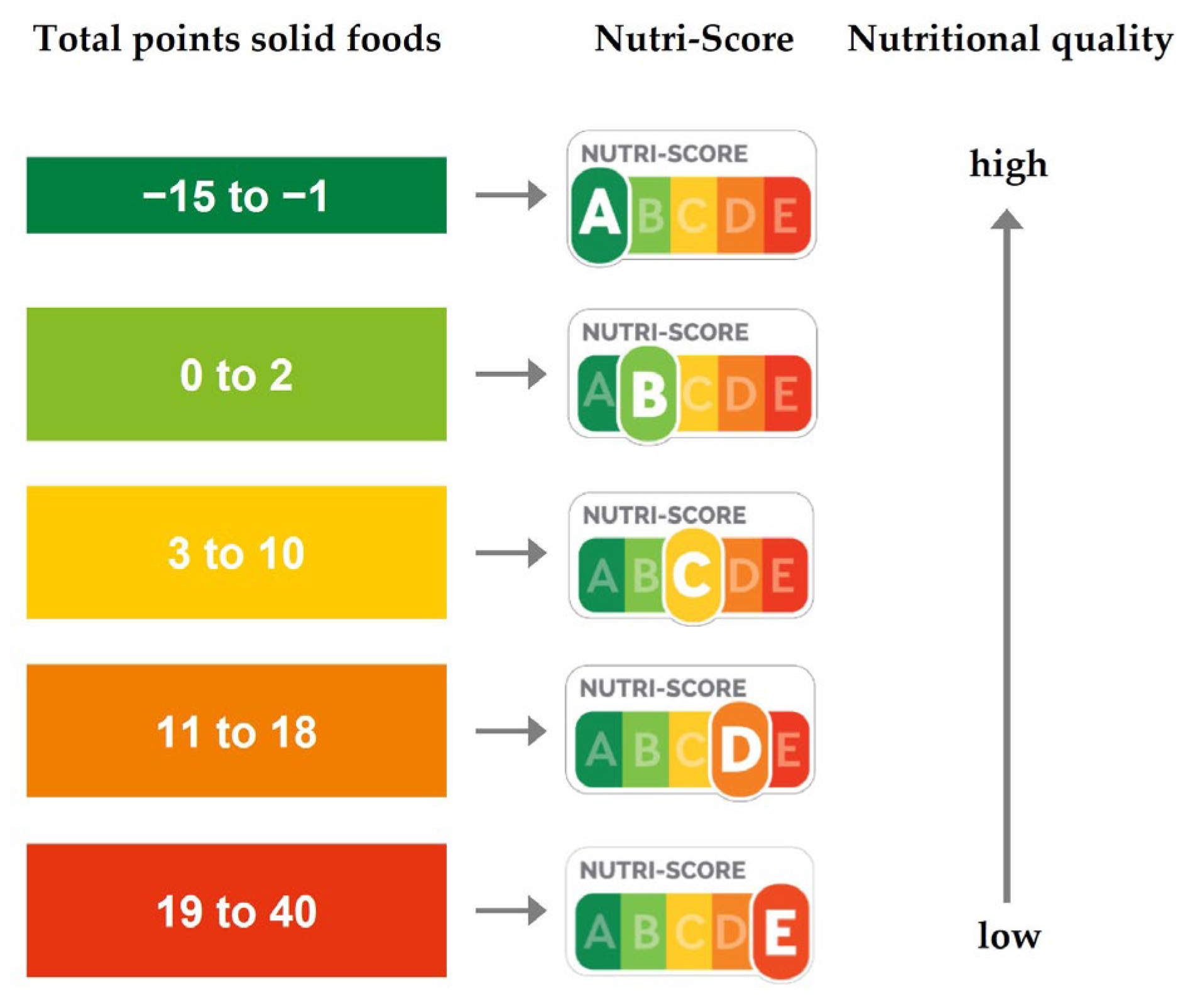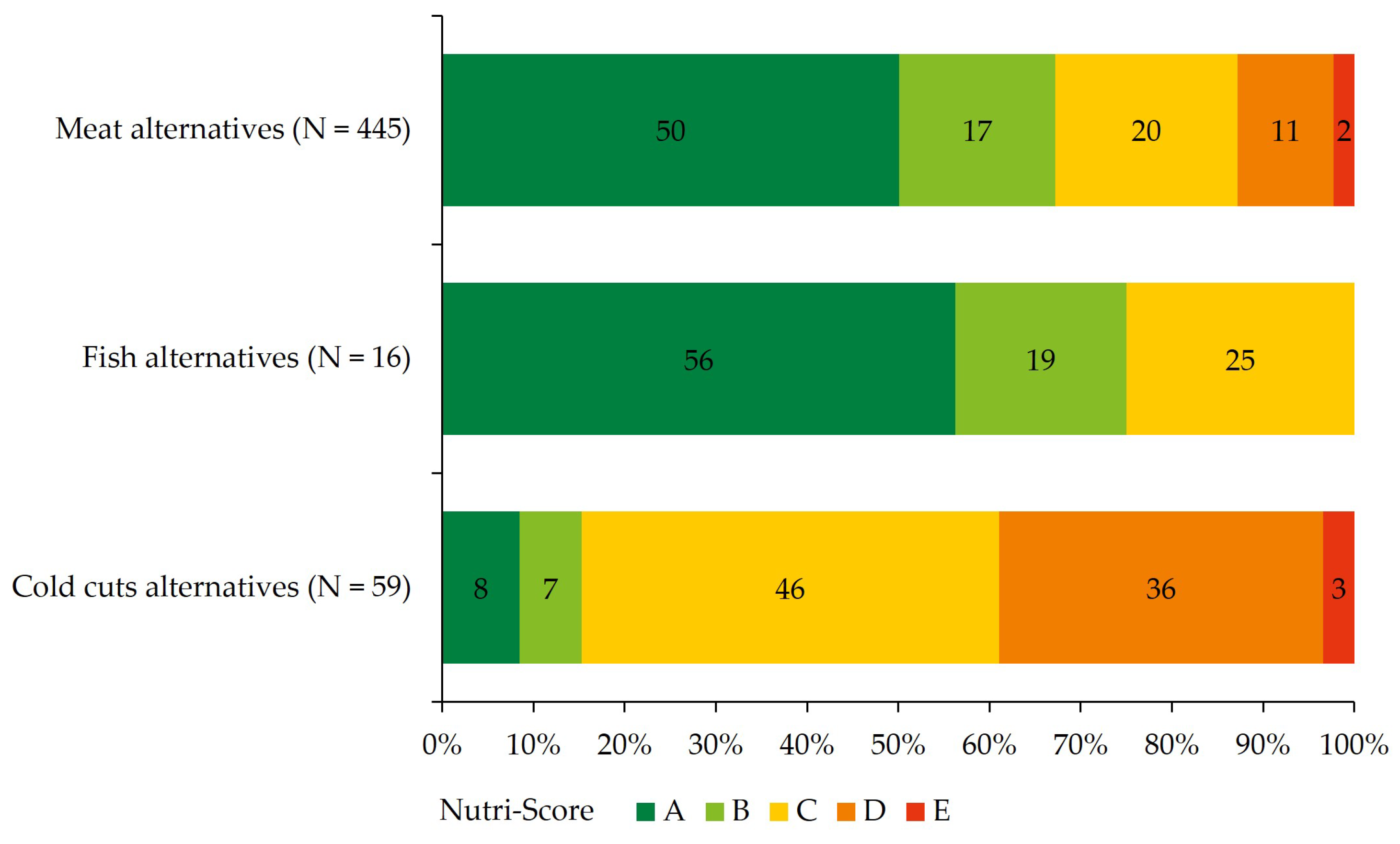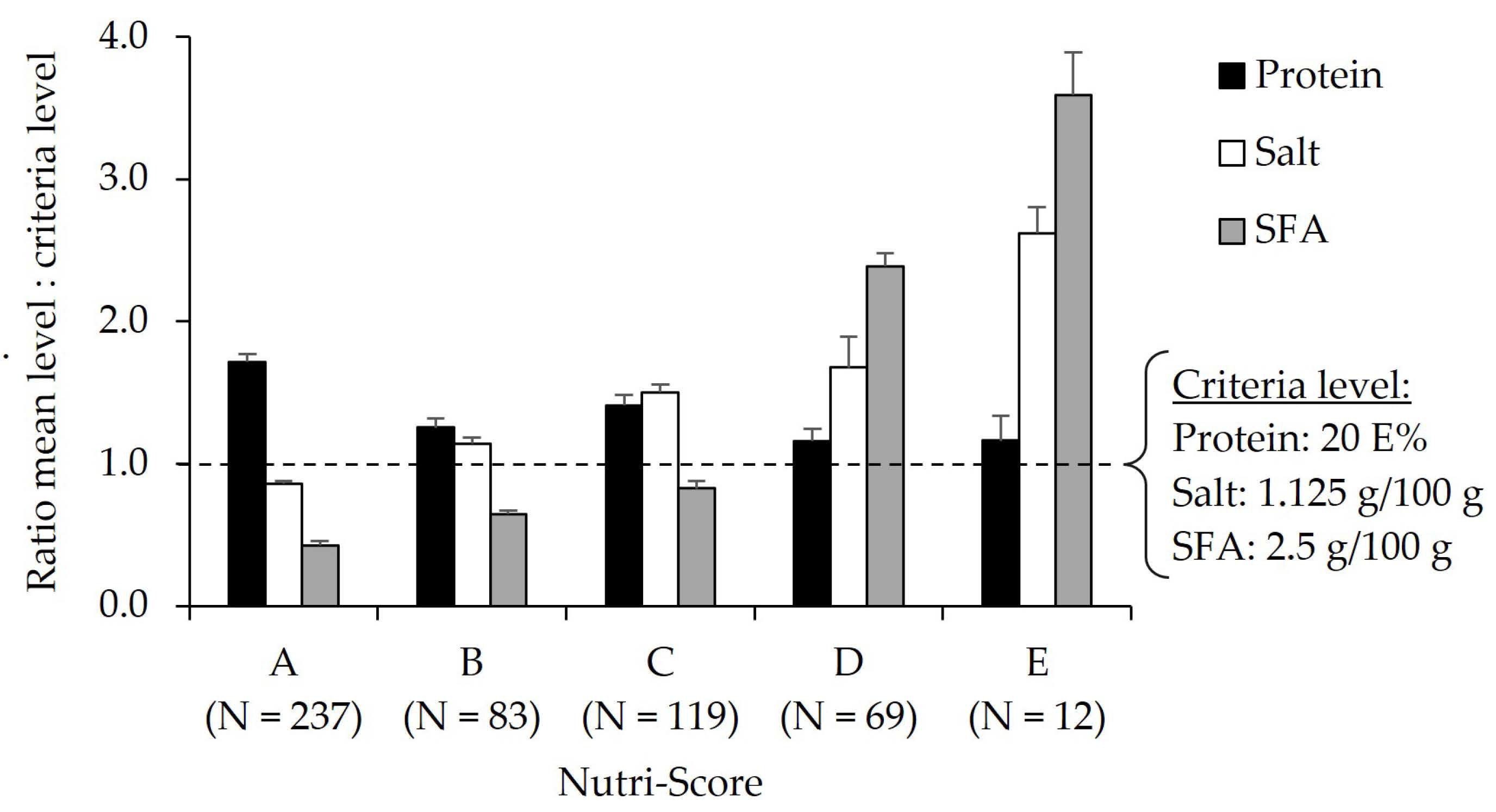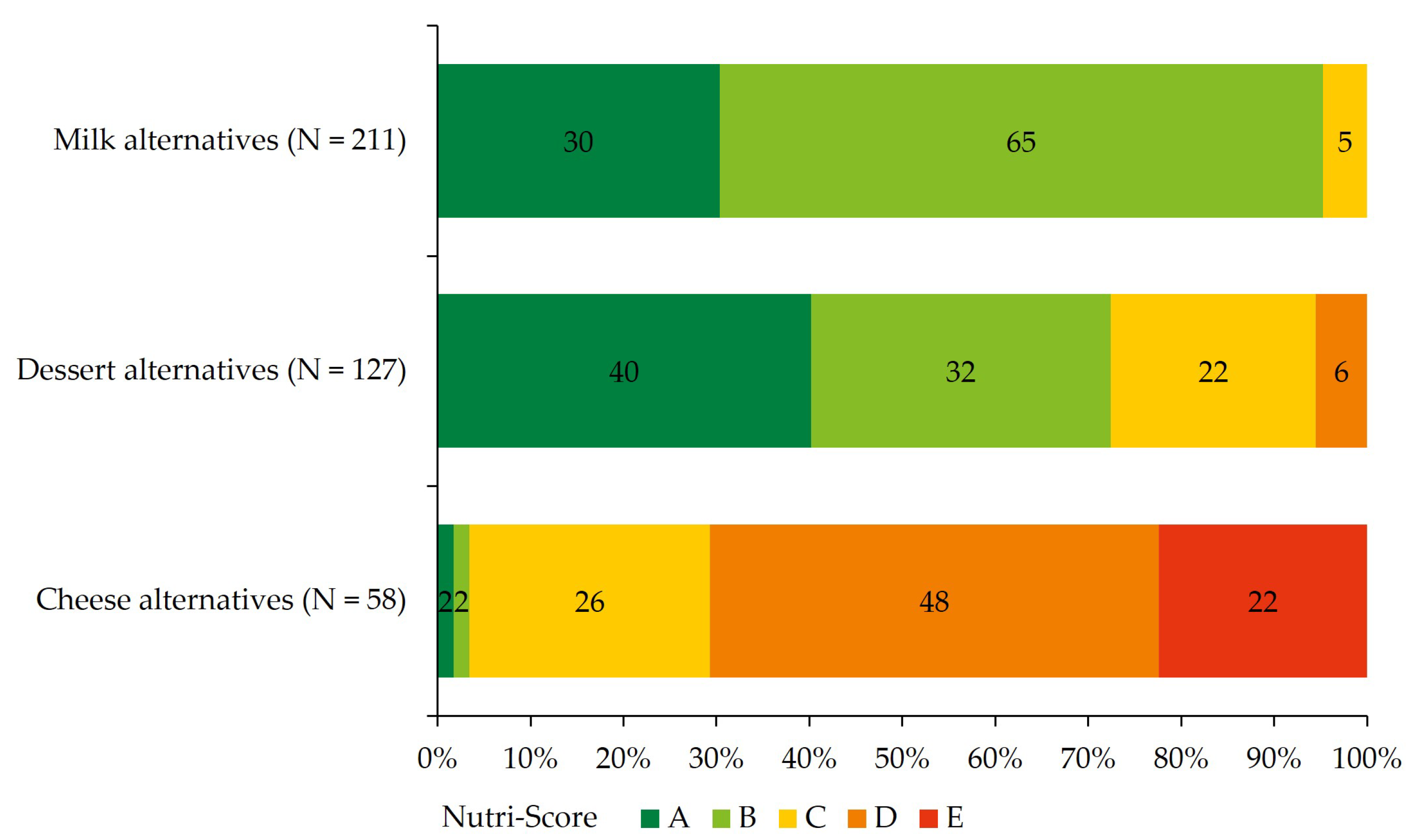Cross-Sectional Study to Map Nutritional Quality of Meat, Fish, and Dairy Alternatives in Dutch Supermarkets According to the Dutch Food-Based Dietary Guidelines and Nutri-Score
Abstract
1. Introduction
2. Materials and Methods
2.1. Product Selection and Data Collection
2.2. Evaluation of Nutritional Quality
2.2.1. Dutch Food-Based Dietary Guidelines (the Wheel of Five)
2.2.2. Nutri-Score
2.3. Data Analysis
3. Results
3.1. Nutritional Quality of Meat, Fish, and Cold Cuts Alternatives
3.2. Nutritional Quality of Milk, Dessert, and Cheese Alternatives
4. Discussion
Author Contributions
Funding
Institutional Review Board Statement
Informed Consent Statement
Data Availability Statement
Acknowledgments
Conflicts of Interest
References
- Smart Protein Project. Plant-Based Foods in Europe: What Do Consumers Want? Available online: https://smartproteinproject.eu/consumer-attitudes-plant-based-food-report/ (accessed on 19 December 2022).
- Smart Protein Project. Plant-Based Foods in Europe: How Big Is the Market? Available online: https://smartproteinproject.eu/plant-based-food-sector-report/ (accessed on 17 January 2023).
- Van Haperen, M. Dierlijk en Plantaardig in de Foodservice—Inkoopcijfers 2016–2021. 21 September 2021. Available online: https://drive.google.com/file/d/1R7VNjDBbs7pGveGsgwV80wVloyNDG9pS/view (accessed on 19 December 2022).
- Willett, W.; Rockström, J.; Loken, B.; Springmann, M.; Lang, T.; Vermeulen, S.; Garnett, T.; Tilman, D.; DeClerck, F.; Wood, A.; et al. Food in the Anthropocene: The EAT-Lancet Commission on healthy diets from sustainable food systems. Lancet 2019, 393, 447–492. [Google Scholar] [CrossRef] [PubMed]
- Crowe, F.L.; Appleby, P.N.; Travis, R.C.; Key, T.J. Risk of Hospitalization or Death from Ischemic Heart Disease among British Vegetarians and Nonvegetarians: Results from the EPIC-Oxford Cohort Study. Am. J. Clin. Nutr. 2013, 97, 597–603. [Google Scholar] [CrossRef] [PubMed]
- Key, T.J.; Papier, K.; Tong, T.Y. Plant-Based Diets and Long-Term Health: Findings from the EPIC-Oxford Study. Proc. Nutr. Soc. 2022, 81, 190–198. [Google Scholar] [CrossRef]
- Huang, T.; Yang, B.; Zheng, J.; Li, G.; Wahlqvist, M.L.; Li, D. Cardiovascular Disease Mortality and Cancer Incidence in Vegetarians: A Meta-Analysis and Systematic Review. Ann. Nutr. Metab. 2012, 60, 233–240. [Google Scholar] [CrossRef] [PubMed]
- Key, T.J.; Fraser, G.E.; Thorogood, M.; Appleby, P.N.; Beral, V.; Reeves, G.; Burr, M.L.; Chang-Claude, J.; Frentzel-Beyme, R.; Kuzma, J.W.; et al. Mortality in Vegetarians and Nonvegetarians: Detailed Findings from a Collaborative Analysis of 5 Prospective Studies. Am. J. Clin. Nutr. 1999, 70, 516–524. [Google Scholar] [CrossRef]
- Cutroneo, S.; Angelino, D.; Tedeschi, T.; Pellegrini, N.; Martini, D.; SINU Young Working Group. Nutritional Quality of Meat Analogues: Results from the Food Labelling of Italian Products (FLIP) Project. Front. Nutr. 2022, 9, 852831. [Google Scholar] [CrossRef]
- Katidi, A.; Xypolitaki, K.; Vlassopoulos, A.; Kapsokefalou, M. Nutritional Quality of Plant-Based Meat and Dairy Imitation Products and Comparison with Animal-Based Counterparts. Nutrients 2023, 15, 401. [Google Scholar] [CrossRef]
- Bryngelsson, S.; Moshtaghian, H.; Bianchi, M.; Hallström, E. Nutritional assessment of plant-based meat analogues on the Swedish market. Int. J. Food Sci. Nutr. 2022, 73, 889–901. [Google Scholar] [CrossRef]
- Pointke, M.; Pawelzik, E. Plant-Based Alternative Products: Are They Healthy Alternatives? Micro-and Macronutrients and Nutritional Scoring. Nutrients 2022, 14, 601. [Google Scholar] [CrossRef]
- Fructuoso, I.; Romão, B.; Han, H.; Raposo, A.; Ariza-Montes, A.; Araya-Castillo, L.; Zandonadi, R.P. An Overview on Nutritional Aspects of Plant-Based Beverages Used as Substitutes for Cow’s Milk. Nutrients 2021, 13, 2650. [Google Scholar] [CrossRef]
- Silva, A.R.A.; Silva, M.M.N.; Ribeiro, B.D. Health Issues and Technological Aspects of Plant-Based Alternative Milk. Food Res. Int. 2020, 131, 108972. [Google Scholar] [CrossRef] [PubMed]
- Vanga, S.K.; Raghavan, V. How Well Do Plant Based Alternatives Fare Nutritionally Compared to Cow’s Milk? J. Food Sci. Technol. 2018, 55, 10–20. [Google Scholar] [CrossRef] [PubMed]
- Park, Y.W. The Impact of Plant-Based Non-Dairy Alternative Milk on the Dairy Industry. Food Sci. Anim. Resour. 2021, 41, 8–15. [Google Scholar] [CrossRef]
- Huybers, S.; Roodenburg, A.J.C. Column: Is Plantaardig Duurzaam En Gezond? VMT. 12 February 2021. Available online: https://www.vmt.nl/45804/column-is-plantaardig-duurzaam-en-gezond (accessed on 17 January 2023).
- Brink, E.; Postma-Smeets, A.; Stafleu, A.; Wolvers, D. Richtlijnen Schijf van Vijf, 6th ed.; Voedingscentrum: Den Haag, The Netherlands, 2020. [Google Scholar]
- Brink, E.; van Rossum, C.; Postma-Smeets, A.; Stafleu, A.; Wolvers, D.; van Dooren, C.; Toxopeus, I.; Buurma-Rethans, E.; Geurts, M.; Ocké, M. Development of Healthy and Sustainable Food-Based Dietary Guidelines for the Netherlands. Public Health Nutr. 2019, 22, 2419–2435. [Google Scholar] [CrossRef]
- Santé Publique France. Available online: https://www.santepubliquefrance.fr/en/nutri-score (accessed on 14 October 2021).
- National Institute for Public Health and the Environment (RIVM). Voedselconsumptiepeiling (VCP) 2012–2016. Available online: https://www.wateetnederland.nl/ (accessed on 22 November 2022).
- Beukers, M.; Geurts, M.; van Rossum, C. MEMO: Inname van Nutriënten door de Nederlandse Bevolking. National Institute for Public Health and the Environment (RIVM), Bilthoven. 2016. Available online: https://www.rivm.nl/documenten/inname-van-nutrienten-door-nederlandse-bevolking (accessed on 17 January 2023).
- Jaarcijfers Aandoeningen—Huisartsenregistraties. Nivel. Available online: https://www.nivel.nl/nl/nivel-zorgregistraties-eerste-lijn/cijfers-over-aandoeningen/jaarcijfers-aandoeningen-huisartsenregistraties (accessed on 13 December 2022).
- Collings, R.; Harvey, L.J.; Hooper, L.; Hurst, R.; Brown, T.J.; Ansett, J.; King, M.; Fairweather-Tait, S.J. The absorption of iron from whole diets: A systematic review. Am. J. Clin. Nutr. 2013, 98, 65–81. [Google Scholar] [CrossRef]
- Drewnowski, A. Most Plant-Based Milk Alternatives in the USDA Branded Food Products Database Do Not Meet Proposed Nutrient Standards or Score Well on Nutrient Density Metrics. Nutrients 2022, 14, 4767. [Google Scholar] [CrossRef] [PubMed]
- Reynaud, Y.; Buffière, C.; Cohade, B.; Vauris, M.; Liebermann, K.; Hafnaoui, N.; Lopez, M.; Souchon, I.; Dupont, D.; Rémond, D. True ileal amino acid digestibility and digestible indispensable amino acid scores (DIAASs) of plant-based protein foods. Food Chem. 2021, 338, 128020. [Google Scholar] [CrossRef]
- Shkembi, B.; Huppertz, T. Calcium Absorption from Food Products: Food Matrix Effects. Nutrients 2021, 14, 180. [Google Scholar] [CrossRef]
- van Tongeren, C.; Jansen, L. Adjustments Needed for the Use of Nutri-Score in the Netherlands: Lack of Selectivity and Conformity with Dutch Dietary Guidelines in Four Product Groups. Int. J. Nutr. Food Sci. 2020, 9, 33–42. [Google Scholar] [CrossRef]
- Ministry of Health, Welfare and Sport. Update of the Nutri-Score Algorithm. The Hague. 29 November 2022. Available online: https://www.rijksoverheid.nl/documenten/publicaties/2022/06/29/update-of-the-nutri-score-algorithm (accessed on 22 November 2022).
- Dutch Health Council. Evaluation of the Nutri-Score Algorithm No. 2022/29e. The Hague. 29 November 2022. Available online: https://www.gezondheidsraad.nl/onderwerpen/voeding/alle-adviezen-over-voeding/evaluatie-van-het-algoritme-van-nutri-score (accessed on 30 November 2022).
- Peters, S.; Verhagen, H. An Evaluation of the Nutri-Score System along the Reasoning for Scientific Substantiation of Health Claims in the EU-A Narrative Review. Foods 2022, 11, 2426. [Google Scholar] [CrossRef]
- National Institute for Public Health and the Environment (RIVM). Nederlands Voedingsstoffenbestand (NEVO). Available online: https://nevo-online.rivm.nl/ (accessed on 29 November 2022).
- Veronese, N.; Solmi, M.; Caruso, M.G.; Giannelli, G.; Osella, A.R.; Evangelou, E.; Maggi, S.; Fontana, L.; Stubbs, B.; Tzoulaki, I. Dietary fiber and health outcomes: An umbrella review of systematic reviews and meta-analyses. Am. J. Clin. Nutr. 2018, 107, 436–444. [Google Scholar] [CrossRef] [PubMed]
- Hall, K.D.; Ayuketah, A.; Brychta, R.; Cai, H.; Cassimatis, T.; Chen, K.Y.; Chung, S.T.; Costa, E.; Courville, A.; Darcey, V.; et al. Ultra-Processed Diets Cause Excess Calorie Intake and Weight Gain: An Inpatient Randomized Controlled Trial of Ad Libitum Food Intake. Cell. Metab. 2019, 30, 67–77.e3. [Google Scholar] [CrossRef] [PubMed]
- Forde, C.G.; Bolhuis, D. Interrelations between Food Form, Texture, and Matrix Influence Energy Intake and Metabolic Responses. Curr. Nutr. Rep. 2022, 11, 124–132. [Google Scholar] [CrossRef] [PubMed]
- Van den Berg, L.A.; Mes, J.J.; Mensink, M.; Wanders, A.J. Protein quality of soy and the effect of processing: A quantitative review. Front. Nutr. 2022, 9, 1004754. [Google Scholar] [CrossRef]





| Nutrient | Unit | Ready-Made Vegetarian Meat Alternatives *1 | Plant-Based Protein Drinks and Desserts | Plant-Based Cheese Alternatives |
|---|---|---|---|---|
| Saturated fatty acids | g/100 g | ≤2.5 | ≤1.1 | ≤14 |
| Trans fatty acids | g/100 g | ≤0.1 | Not added | Not added |
| Total sugar | g/100 g | Not added | ≤6 | Not added |
| Protein | E% | ≥20 | ≥20 | ≥20 |
| Salt *2 | g/100 g | ≤1.125 | ≤0.15 | ≤2.05 |
| Calcium | mg/100 g | NA | ≥80 | ≥500 |
| Iron | mg/100 g | ≥0.8 | NA | NA |
| Vitamin B12 | mcg/100 g | ≥0.24 | ≥0.24 | ≥0.24 |
| Vitamin B1 *3 | mcg/100 g | ≥0.06 | NA | NA |
| Nutrient | Unit | Meat Alternatives (N = 445) | Fish Alternatives (N = 16) | Cold Cuts Alternatives (N = 59) | |||
|---|---|---|---|---|---|---|---|
| Saturated fatty acids | g/100 g | 1.20 | (0.80–2.40) a | 0.90 | (0.60–1.70) a | 1.50 | (1.40–3.40) b |
| Meet criteria (%) | 77 | 88 | 68 | ||||
| Salt | g/100 g | 1.30 | (1.00–1.53) a | 1.06 | (1.00–1.31) a | 1.70 | (1.40–1.90) b |
| Meet criteria (%) | 39 | 63 | 12 | ||||
| Protein | E% | 28.96 | (18.56–42.34) a | 15.20 | (9.63–25.10) b | 13.16 | (8.16–20.00) b |
| Meet criteria (%) | 72 | 44 | 25 | ||||
| Iron | mg/100 g | 0.00 | (0.00–2.10) a | 0.00 | (0.00–1.58) a, b | 0.00 | (0.00–0.00) b |
| Meet criteria (%) | 30 | 25 | 8 | ||||
| Vitamin B12 | µg/100 g | 0.00 | (0.00–0.30) a | 0.00 | (0.00–0.29) a, b | 0.00 | (0.00–0.00) b |
| Meet criteria (%) | 28 | 25 | 5 | ||||
| Meet all criteria | % | 3 | 13 | 0 | |||
| Nutrient | Unit | Milk Alternatives (N = 211) | Dessert Alternatives (N = 127) | Cheese Alternatives (N = 58) | |||
|---|---|---|---|---|---|---|---|
| Saturated fatty acids | g/100 g | 0.30 | (0.10–0.40) a | 0.50 | (0.30–2.40) b | 11.30 | (6.00–20.00) c |
| Meet criteria (%) | 92 | 68 | 57 | ||||
| Total sugar | g/100 g | 2.50 | (0.20–4.80) a | 4.10 | (0.70–9.07) b | 1.30 | (0.00–2.55) c |
| Meet criteria (%) | 86 | 58 | 100 | ||||
| Protein | E% | 6.78 | (2.55–15.38) a | 9.89 | (4.05–21.14) b | 5.96 | (1.90–13.99) a |
| Meet criteria (%) | 20 | 29 | 2 | ||||
| Salt | g/100 g | 0.10 | (0.08–0.13) a | 0.10 | (0.05–0.18) a | 1.44 | (1.00–1.93) b |
| Meet criteria (%) | 92 | 72 | 84 | ||||
| Calcium | mg/100 g | 0.00 | (0.00–120) a | 0.00 | (0.00–120) a | 0.00 | (0.00–0.00) b |
| Meet criteria (%) | 36 | 31 | 0 | ||||
| Vitamin B12 | µg/100 g | 0.00 | (0.00–0.38) a | 0.00 | (0.00–0.38) a, b | 0.00 | (0.00–0.00) b |
| Meet criteria (%) | 31 | 28 | 7 | ||||
| Meet all criteria | % | 9 | 3 | 0 | |||
Disclaimer/Publisher’s Note: The statements, opinions and data contained in all publications are solely those of the individual author(s) and contributor(s) and not of MDPI and/or the editor(s). MDPI and/or the editor(s) disclaim responsibility for any injury to people or property resulting from any ideas, methods, instructions or products referred to in the content. |
© 2023 by the authors. Licensee MDPI, Basel, Switzerland. This article is an open access article distributed under the terms and conditions of the Creative Commons Attribution (CC BY) license (https://creativecommons.org/licenses/by/4.0/).
Share and Cite
Huybers, S.; Roodenburg, A.J.C. Cross-Sectional Study to Map Nutritional Quality of Meat, Fish, and Dairy Alternatives in Dutch Supermarkets According to the Dutch Food-Based Dietary Guidelines and Nutri-Score. Foods 2023, 12, 1738. https://doi.org/10.3390/foods12091738
Huybers S, Roodenburg AJC. Cross-Sectional Study to Map Nutritional Quality of Meat, Fish, and Dairy Alternatives in Dutch Supermarkets According to the Dutch Food-Based Dietary Guidelines and Nutri-Score. Foods. 2023; 12(9):1738. https://doi.org/10.3390/foods12091738
Chicago/Turabian StyleHuybers, Sylvie, and Annet J. C. Roodenburg. 2023. "Cross-Sectional Study to Map Nutritional Quality of Meat, Fish, and Dairy Alternatives in Dutch Supermarkets According to the Dutch Food-Based Dietary Guidelines and Nutri-Score" Foods 12, no. 9: 1738. https://doi.org/10.3390/foods12091738
APA StyleHuybers, S., & Roodenburg, A. J. C. (2023). Cross-Sectional Study to Map Nutritional Quality of Meat, Fish, and Dairy Alternatives in Dutch Supermarkets According to the Dutch Food-Based Dietary Guidelines and Nutri-Score. Foods, 12(9), 1738. https://doi.org/10.3390/foods12091738






